NMSK - biomechanics
1/77
There's no tags or description
Looks like no tags are added yet.
Name | Mastery | Learn | Test | Matching | Spaced |
|---|
No study sessions yet.
78 Terms
what do bios and mekhaniki mean?
what is biomechanics
bios = life
mekhaniki = mechanics
biomechanics = applying mechanical laws to living things by studying the mechanics of a living body the forces and their effects on and within the body
what does biomechanics act on?
inside the cell to the whole animal
what is classical mechanics
how bodies (solids/fluids) or systems of bodies responds to external forces
what is meant by a system of levers
bones of the skeleton form a system of levers
lever = rigid object rotates around a fixed point
most muscles act on tendons to change joint angles
what is functional anatomy?
applying principles of biomechanics to work out how structures function
how can we infer functional anatomy
examine muscle action relative to one joint axis of rotation
infer joint action based on orientation and pull of muscle in anatomical position
some are easier than others
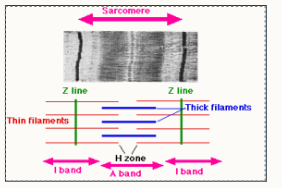
outline material properties of muscles
ability to shorten: to 50% of original length, dertermined by muscle length)
parallel formation of fibres: greater range of motion (ROM), less force developped
amount of tendon and tendon:muscle ratio: affects force and ROM potential of a muscle
muscle power: determined by cross-sectional area of muscle, determined where fibres join tendons at an angle
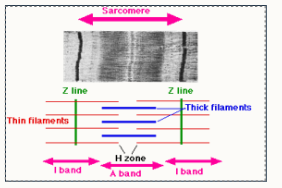

outline muscle architecture
Variation in fibre arrangement in muscle belly:
strap muscle (e.g. infrahyoid muscle)
fusiform muscles (e.g. spindle shaped)
pennate

what does ACS and PCS stand for?
ACS = widest part of muscle belly
PCS = total area of muscle at right angle to muscle fibres
what is a compromise made in pennate muscle?
Creates a large cross-section and force
BUT
less range for shortening
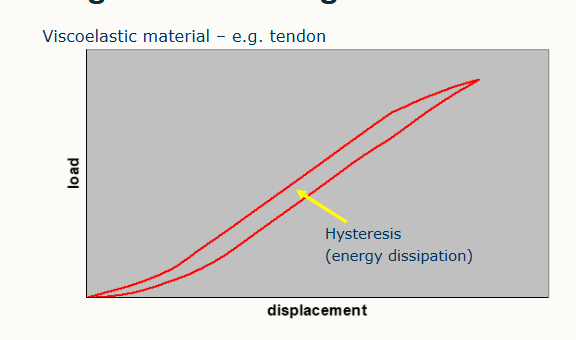
what is hysteresis and where do we find it in this graph?
hysteresis = energy dissipation during loading and unloading
found in the space of the lines.
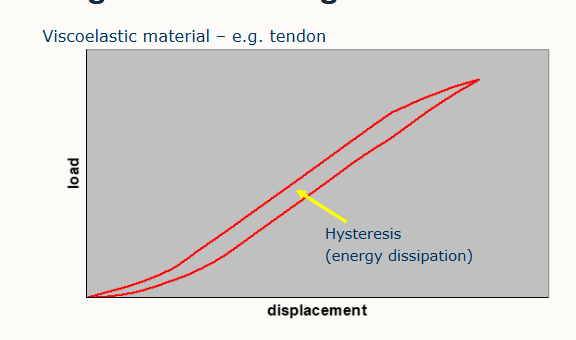
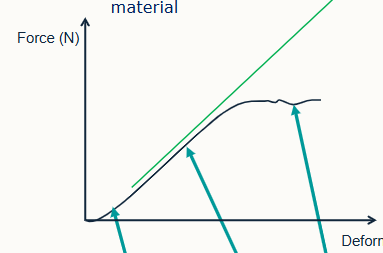
explain this graph
Loading to failure
force (N) against deformation (mm)
linear region = elastic deformation = reversible
yield region = plastic deformation = irreversible
3 regions: toe region, linear region, yield and failure
green line (line at 45 degrees), young’s modulus linear gradient.
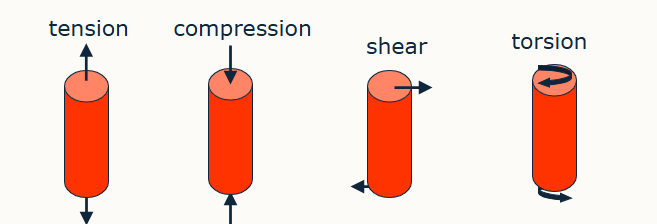
what are 4 ways force can be applied
tension
compression
shear
torsion
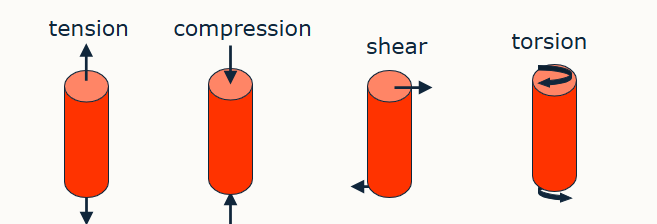
What is wolff’s law for bone?
bone acts as a piezoelectric crystal
bending generates microcurrents
osteocytes sense currents
compression = negative charge = lay down bone
tension = positive charge = remove bone
eventually bone adapts to the forces applied
why is wolff’s law important
fracture healing and rehabilitation
slower healing than soft tissue adaptions
stress cracks are evident the animal is being exercised in excess of current fitness
what will compression cause
negative charge
lay down bone
what will tension cause
positive charge
removal of bone
name 2 important characteristics of bone
not homogenous (mechanical behaviour is influenced by direction of loading relative to its orientation) anisotropic
bone is most resistant to compression in all directions
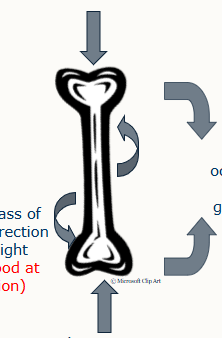
outline the forces acting on the bone in this image - when are each of these forces occuring:
torsion, bending, tensile and axial compression
Torsion - occurs when mass of body changes direction while limb weight bearing
Bending - occurs when bone at angle on weight bearing/greater pull of muscles on one side
tensile force = stretching forces
axial compression = when weight bearing, muscle contractions contribute
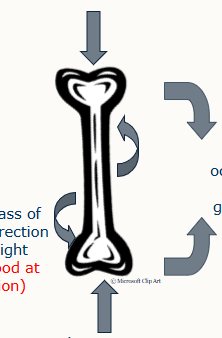
what are stress and strain?
stress = magnitude of this resistance
strain = amount the object deforms
what do fractures often form from?
Caused by tension
configuration results of:
type of loading
rate the load is applied
what fracture lines may appear as a result of different types of loading?
tension - transverse lines
compression - oblique lines (shears at 45 degrees to long axis)
rotation - spiral fracture
bending - butterfly fragments
as bone bends, convex side is under tension, concave under compression. Transverse fracture but shears at 45 degrees proximal and distal to form a butterfly fragment
outline fracture formation based on rate of loading in cortical bone
SLOWLY:
fracture starts at weakest point, follows weakest path
single like of fracture is influenced by load applied and any weakness present
RAPIDLY:
energy stored in structure causes multiple sites of disruption
not necessarily along weakest plane
what may high energy trauma lead to?
high degree of comminution
outline fracture formation due to rate of loading in cancellous bone
follows some fracture patterns as seen in cortical bone
compressive force = collapse and compaction
typically seen in vertebrae
outline bone physiology in fractures
bone has capacity to heal
inflammation - stages of soft to hard callus - eventually forms bone of original tissue
what do we want to optimum healing
some movement (wolff’s law) to stimulate bone formation = promotes callus formation and increases rigidity.
excessive movement prolongs fracture healing
outline the 4 stages of bone healing
fracture
haematoma forms
hard callus forms
bone remodelling
what is the purpose of fracture fixation
minimise strain of fracture callus
allow healing to occur
spatial realignment
takes load until bone is strong enough
weight bearing on limb
reconstruct the original structure
neutralise forces acting on fracture site.
what 5 options do we have for fixation options?
splints and casts
external fixator
plate and screw
intramedullary rod
interlocking nails
why do we use splints and casts?
immobilise fractures
do not directly contact bone
rigid material
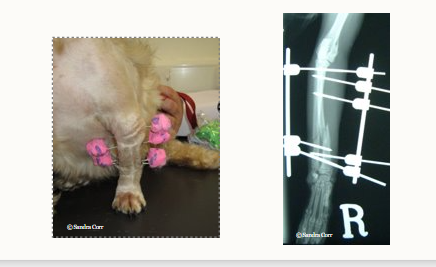
what are external fixators used for
complex fractures
used where there is high risk
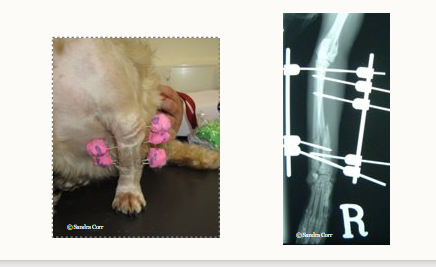
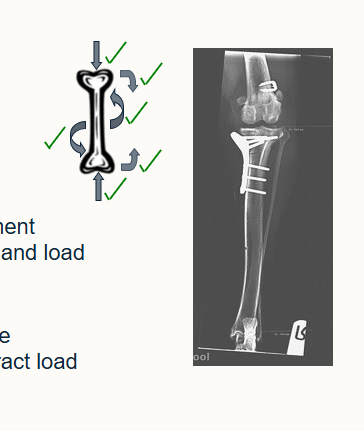
why and how are plates and screws used?
resist all 3 forces
screws:
apply friction between plate and bone
apply compression between fragments
plate:
internal splint, hold fractures parts in alignment
allows compression between fracture ends and load transfer
long bones loaded eccentrically:
results in tension side and compression side
position plate on tension side helps counteract load compressing on opposite side
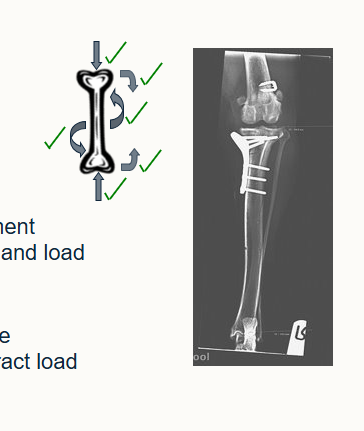
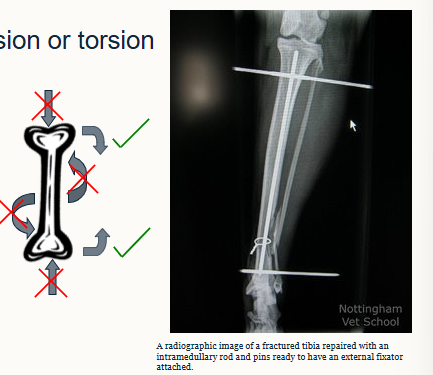
what are intramedullary rods used for
little resistance to axial compression/torsion
resist bending forces
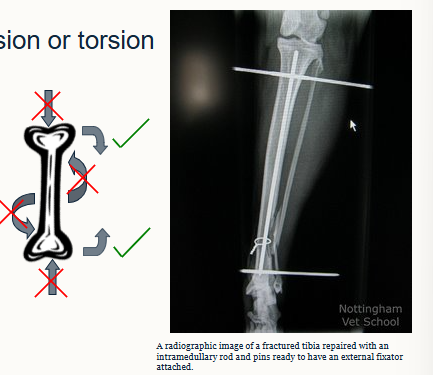
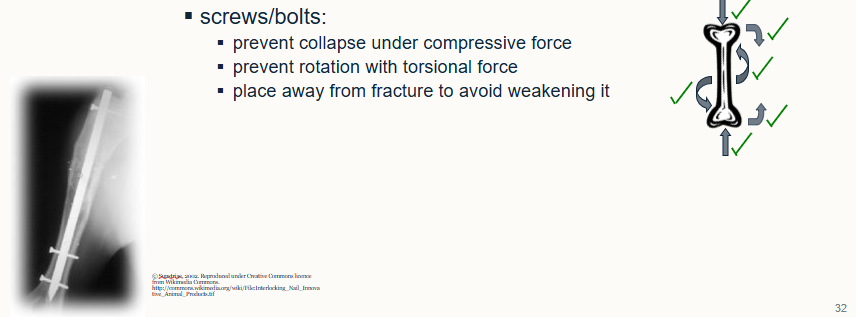
how are interlocking nails used
resist all 3 forces
central nail resists bending
screws/bolts:
prevent collapse under compressive force
prevent rotation with torsional force
place away from fracture to avoid weakening it
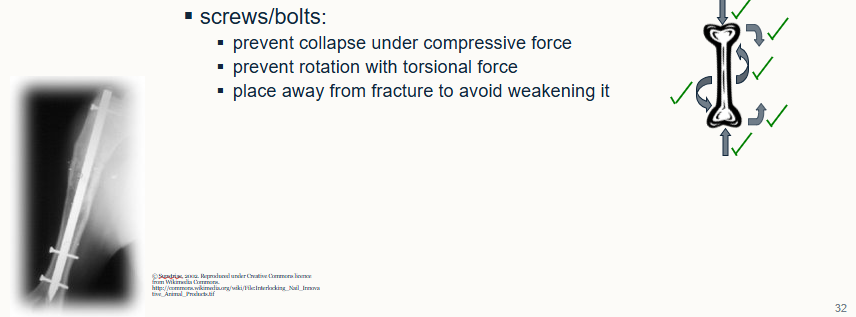
give an example of a surgical intervention and how they assessed its functionality
tibiotarsal bone plate
Aim: improve surgical repairs
Validate surgical procedure: increase fatigue strength of surgically repaired tibiotarsal jionts
Biomechanical study on the hindlimb: - strain gauges mounted to bone plates, test efficacy of added IM rod in this procedure
Tested by compressive loading noted: increase in fatigue life via reduction in plate strains and increase in structural stability due to IM rod in tibia.
what 5 aspects do we consider with conformation?
structural arrangement
species/breed standards
indicator of performance and soundness
subjective/objective assessment
implications?
what guidelines do we use for conformation?
reference points identified
look at length and angles
what is conformation and why is it important
alignment of bones and joints
critical to performance
what can conformation cause/lead to
determination of foot shape
how food wears over time
how leg moves during locomotion
some abnormalities simply reduce visual appeal, others can lead to lameness
knowing proper conformation can help us recognise problems before lameness occurs
what is a problem with breeding
breeding for looks at the compromise of performance
give 4 examples of breeding conformation complications
daschund = disc problems
bulldog = respiratory and limb problems
pig = conformation problems, accentuated by farming demants
GSD = low hips, back problems
give 3 key ideas for conformation
solid structures last for years
weaker structures aren’t able to withstand much
always exceptions to the rules
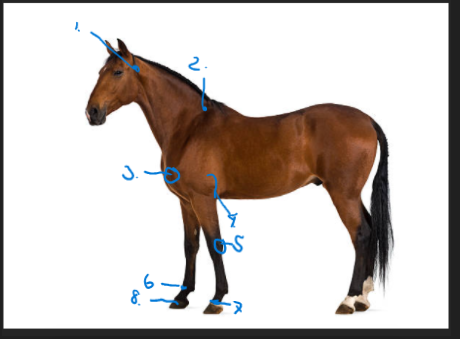
identify the following points on this image of the horse:
wing of atlas
proximal end of spine of scapula
prosterior part of greater tubercle of the humerus
elbow joint
lateral tuberosity of distal end of radius
articulation of carpus and metacarpal bones
distal end of third metacarpal bone
articulation of first pastern joint (between the proximal and middle phalanges) and phalanx.
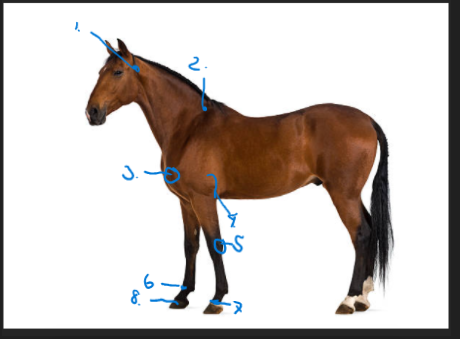
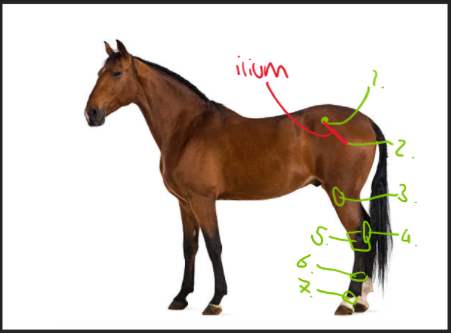
Label these parts of the horse
proximal end of ileum
greater trochanter of femur
stifle joint
calcaneus bone
articulation of tarsus and tarsal bones
articulation of fetlock joint and metatarsal bone
articulation of pastern joint

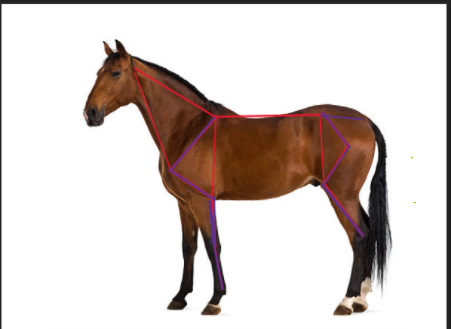
on this horse draw the following lines between::
shoulder inclination
shoulder joint
elbow joint
fetlock joint
pelvis inclination
femur inclination
stifle joint
hock joint

Outline 7 key facts about greyhounds
third fastest land animal
second fastest acceleration
body mass range 22-40kg
females = 27.8 and males = 32.7kg average
races range from 250-1000m, 470m average
17s for 280m
average race is 30.5s for 480m
outline the muscle fibres found in canines and specifically greyhounds
type 1
type 2: IIA and IIX and IID (IID only found in dogs)
more fat
better adapted for endurance
IID:
- a mix of type 1 and type 2 fibres which enables the dog to be goodo at both endurance and sprinting.
Why do greyhounds need energy?
ATP used for myosin-ATPase from actin
sources overlap: aerobic respiration, glycolysis, creatin phosphate
as greyhounds exit the trap, they’re at full power, need to produce ATP very very quickly
What happens in the absence of O2 during respiration (i.e. during those first moments when they greyhound exits the trap)
no aerobic respiration reaction can take placce that quickly
Lactate:
lactate is produced from pyruvate during glycolysis (an anaerobic reaction)
allows NAD+ regeneration
H+ are consumed
keeps glycolysis going when no O2 is available
H+ produced by ATP hydrolyssi
lactate and H+ are handled differently
produced in parallel by separate processes (glycolysis and hydrolysis reaction)
Outline exercise physiology in greyhounds in sprint races
sprint races rely on interconversion of AMPADP/ATP and creatine phosphate
totally anaerobic in muscles
all about acceleration
better in males
tends to be more in large male greyhounds
2ADP —> ATP + AMP
Creatine + ATP —> Creatine-P + ADP
why is creatine phosphate so useful?
quick regeneration
anaerobic
enables quick production of energy
outline exercise physiology in standard races
switches to glycolysis for 15-30s
glycolysis = major factor in performance
aerobic processes dominant after 30s
acidosis due to ATP hydrolysis
post-race panting
why is there post race panting?
acidosis
ATP + H2O —> ADP + Pi + H+ + Energy
Outline exercise physiology in long distance races
aerobic after 30s
suits smaller females
fading towards end of race due to metabolic acidosis
What is the Duty Cycle
Running forces are cyclical
Duty cycle/factor:
equal to contact time/total stride time
expressed as proportion (0-1)
as duty cycle falls impact force increases
impulse of contact time has to propel body in a leap
Deceleration of a limb at contact:
F=ma
as deceleration decreases so does force.
Explain F1 x T1 = F2 x T2
When standing still, the force applied and the duration it’s applied for is equal on all 4 feet. (F1 x T1)
If we reduce the time each foot spends on the ground e.g. when running, the force each foot must overcome and experiences on contact with the ground increases
because T2 x F2 must be equal to F1 x T1.
If T2 decreases, F2 must increase
When an animal goes from standing still to walking to running, why does the force applied to each limb increase?
need to overcome gravitational force
feet spend less time on the ground
force increases
If we have a 30kg greyhound that goes from standing still to running with 10% of limb contact with ground, what is the new force applied to each limb?
F1 x T1 = F2 x T2
F1 = 30kg (should be in Newtons)
T1 = 100s (for ease)
T2 = 10% therefore 10s
F2 = ?
30 × 100 = 3,000
3,000/10
300kg per limb.
Outline the force of balance in relation to moving in a curve
any object moving in a curve experiences centripetal acceleration
in unstable models, lean-in balances this with gravity
independent of mass
only velocity, radius and g are important
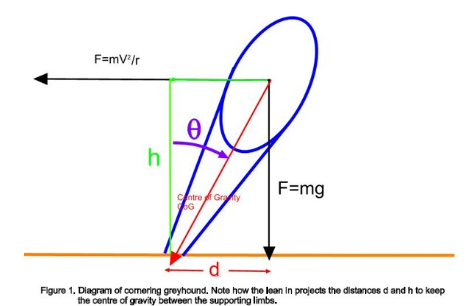
what forces are there on a bend?
When leaning in, G increases
when on a 45 degree tangent, + ~1 G on top of normal body weight
This is because even more weight is placed onto the inner limbs
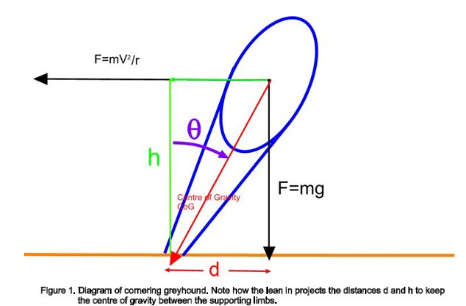
If we have a 30kg greyhound running with each limb experiencing 300kg (N). What force is applied on each limb when running round a curve with a 45 degree tangent?
+1G, therefore now experiencing around 2G on the bend
this is equal to around 1.5 x bodyweight
therefore 300 × 1.5 = 450kg
Why are there so many hindlimb retractors?
muscle force-length curves
muscles grouped so that Force-length curves peak at different joint angles
produces even force over a joint range of motion
different lever arms also alter force-angular velocity relationship
e.g. gluteal muscles vs caudal thigh muscles
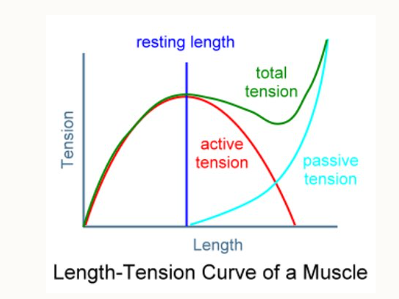
Outline passive and active tension
Hindlimbs = power and acceleration
Forelimbs = breaking and steering/spring
Red line (upside down U shaped curve) = as muscle starts short, gets longer and longer, tension increases then decreases
Can’t be sustained
As active tension starts to decrease, passive tension increases
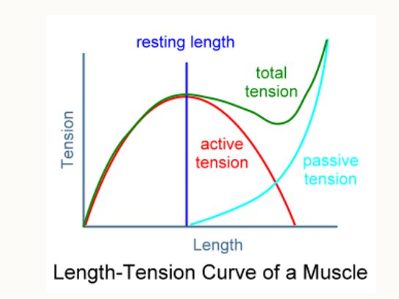
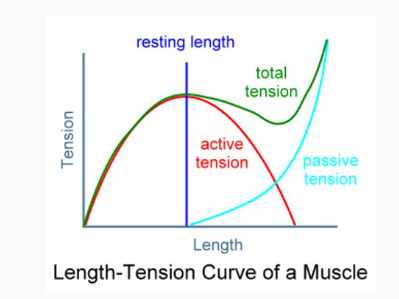
How do we overcome the length-tension curve of a muscle in the hindlimbs?
large range of motion in the hindlimbs that can’t be controlled by one muscle alone
set to act at different times of the hindlimb swing
each muscle pulls hard as limb swings past it’s optimal point (top of the red line, the upside down U curve)
enables most muscles to be working at optimal tension.
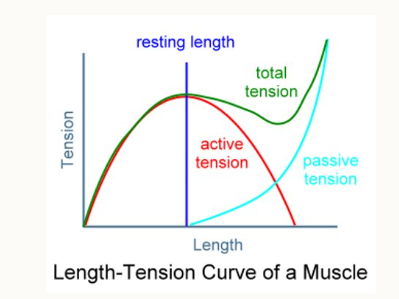
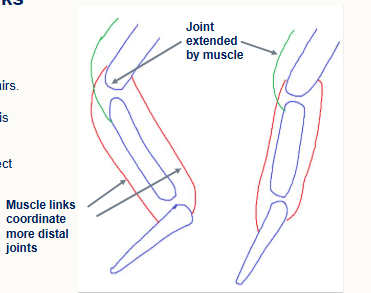
Outline muscles and links
in cursorial animals tend to cross 2 joints
work in antagonistic pairs
link is made, flexion and extension of joints is coordinated without multiple muscle contractions
single extensor can affect many joints distally
examples:
elbow-shoulder
elbow-carpus
hip-stifle
stifle-tarsus-digits
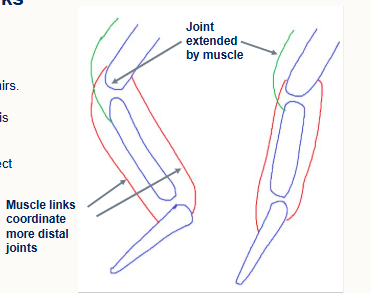
why are bone clinically important in greyhound racing?
dog is producing centripetal acceleration
loads the OUTSIDE limbs
hard track = medial aspect of OUTSIDE limb receives most load
60-70% more BW (body weight) on hind limbs, more on right hind
which bones can over-stress in greyhound racing?
cuboidal tarsal bones
central and third tarsals
metatarsals/metacarpals
sesamoid bones within interosseus muscle tendons
phalanges
How does force applied change based on ground type?
soft ground = equal loading on both sides of the limb
Hard ground = more loading on the inside of the limb - unshared proportion of load of what we calculated
If a greyhound has a stress fracture, how do we treat it?
lag time between repeated stresses and increase in strength = danger period
bone remodelling can’t keep up with stress fracture formation
Wollf’s law - want to reduce exercise so bone can heal but not stop exercise because remodelling needs to be stimulated.
why is remodelling a good thing?
bone strengthens and becomes more rigid
peak force can be increased
failure occurs at higher forces
Downside:
fewer warning signs due to lack of micro-fractures causing lameness
Outline tendon injury clinical relevance in greyhound racing
tendons that take bodyweight and deal with propulsive forces = more prone to injury
e.g. carpal flexors, tarsal extensors, deep and superficial digital flexors
sometimes tendon of origin for biceps brachii
Rare = triceps brachii tendon of insertion, quadriceps (patellar) tendon of insertion
what can greyhounds to at highspeed that they can’t when at rest and what does this indicate?
bend the carpal joint to 90 degrees, parallel to ground
injury isn’t often due to inherent strength and design of the skeletal system
what is the role of a track vet?
check all dogs for injury, lameness, season (females can’t race if in season), general appearance
maintain welfare standards
first aid
minor sales - vaccines, wormers
GBGB official and Veterinary surgeon
no vet = no race
what do we need to consider for a greyhound to be considered fit to race
lameness
wounds
in season? (pro-oestrus and oestrus)
general well-being
what are we looking for to identify injuries in greyhounds during the race?
classic in their site and how they occur = indirect injury
gracilis - out of traps and on first bend
tarsus, carpus, triceps - on bends
watch for tail lifting, whirling
stumble - one stride missed
cramp
running wide/uneven cornering
listen for squeaking/yelping
0.3% injury rate
what do we need to consider about injuries as a track vet and what do we provide?
some injuries aren’t apparent until next day
basic first aid
fracture stabilisation
wounds
euthanasia
arranging further vet consultations
define biomechanics
the study of mechanics of a living body, especially of the forces and effects of these forces on and within the body